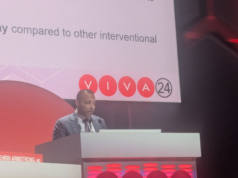Therapies in deep venous thrombosis (DVT) have been slow to advance over the past 50 years. Recently, growing awareness and improvements in tools and techniques have piqued interest in venous disease. The ATTRACT trial will try to answer the question of whether pharmacomechanical thrombolysis truly improves outcomes over anticoagulation alone. The hope is to identify the population of people we should be treating with intervention. My fear is that the techniques used are variable and the access sites are operator dependent.
I believe that acute femoral popliteal disease can be treated safely and effectively with thrombolytics overnight but the popliteal inflow is only cleared when posterior tibial access is employed. Currently, this is not the standard of care in the USA. If the ATTRACT trial does not show a benefit of thrombolysis in this population, I would like to have the questioned answered as to benefit using the posterior tibial approach.
Treatment of chronic femoral popliteal DVT for ulcers is gaining favour and in my experience is highly effective although still in early trial phase. This degree of post-thrombotic syndrome (PTS), however, is seen in just a small portion of persistently symptomatic patients. Some patients simply have swelling and intermittent calf cramping which would be characterised as “mild to moderate PTS” in many studies. In reality, the inability to wear shoes normally, work without limitations and live pain free are described by these patients as life-altering. This may be prevented by early intervention of acute DVT. Some argue that thrombolysis is expensive. I wonder if this cost could be offset by shorter courses of anticoagulation after thrombus clearance. This would potentially decrease costly complications of anticoagulation and decrease the use of expensive drugs. Additionally, studies have shown that residual abnormal veins lead to an increased risk of recurrent DVT. If this recurrence is also decreased by early thrombus resolution, there would be added cost benefit.
Ultimately, the key question to answer is: taking into consideration clinical outcomes, quality of life and cost measures, where is the balance between removing thrombus in the acute phase and treating patients later with chronic venous recanalisation? It is necessary to realise, as well, that procedures to treat chronic DVT are significantly more technically challenging and have worse long-term patency.
Finally, while controversial, I would like to see the question of appropriate iliac vein stent sizing answered. Recent literature and podium speakers encourage the concept that bigger is better. A recent article by Kibbe et al, evaluated the size of the native common iliac vein (CIV) on CT in patients who did not have venous symptoms. The average right CIV was 12.3mm and the left 12.1mm. This is very different from the suggestion that 16mm stents are too small in the CIV. My concern is that gross oversizing of stents, may lead to altered flow dynamics and stretching of the external iliac vein, with resulting restenosis. In fact, in one paper that recommends 16–18mm stents, the reintervention rate was as high as 70%. More importantly, a recent article by Hoffman and colleagues from Stanford, USA, did not show any clinical difference in symptom relief in patients stented with 10mm vs. 18mm stents. Accurate stent placement is critical and secondary interventions are expensive. Currently available 16mm stents are very difficult to place accurately. I would rather see a 14mm stent placed correctly than a 16mm stent placed incorrectly. It is often difficult to restore original patency once a stent has thrombosed. Stents need to be easier to place and privileges for placing venous stents should be limited to properly trained physicians.
These are the questions that we can answer today. Looking forward, I hope that with the combined efforts of scientists, engineers, physicians and industry, we will find drugs and devices to remove chronic thrombus, or better yet a parenteral drug to clear acute thrombus and prevent the development of chronic venous occlusions and PTS.
Elizabeth Brooke Spencer is chairperson of Radiology and Interventional Radiology, Littleton Adventist hospital, Greater Denver Area, USA. She consults for Volcano and Boston Scientific and is the site principal investigator for the Cook, Virtus and Medtronic stent trials












